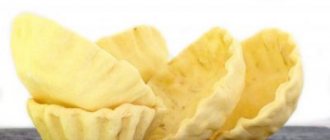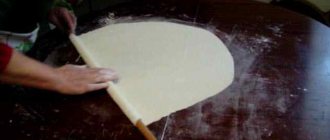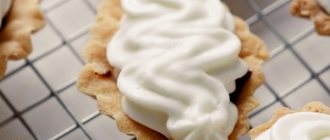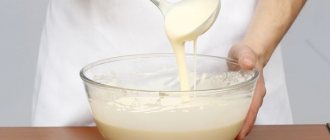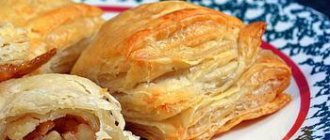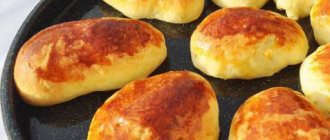Classic recipe for all types of baking
The classic composition of Viennese dough is distinguished by the indispensable presence of sour cream, vanilla sugar and margarine. The classic recipe also has two options - multi-hour and quick. It’s worth trying both the first and the second!
To prepare dough for long-term kneading you will need:
- flour - as much as you need (it’s better to have about 3 kg at home);
- milk - 1 l;
- margarine for baking - 150 g;
- sour cream (better from 20%) - 0.5 l;
- eggs - 10 pcs.;
- yeast - 75 g briquettes;
- sugar - 500 g;
- salt - as usual.
Process:
- In half a glass of milk, dilute a little less than half the yeast and 2 tsp. granulated sugar, salt. Stir thoroughly. The mixture should stand for 15 minutes in a warm place.
- Heat the rest of the milk (do not let it boil) and add margarine, sour cream, sugar and eggs.
- After 15 minutes, mix both mixtures. Adding a little into the flour, you need to achieve the consistency of thick sour cream.
- The kneaded dough should rise 2 times. After the first rise, you should stir it again and wait.
- When the second rise of the dough occurs, you need to add more flour to it (as much as it takes) and knead the dough. It should be kneaded for a very long time. The longer, the more tender and fluffy the baked goods will be.
- When the batch becomes elastic, smooth and fluffy, it needs to be covered and kept warm. This stage is also quite long.
- The risen dough must be kneaded and left to rise again.
- The batch should almost double in size. Now you can cut off pieces from the dough and form baked goods.
- Next, the products should be placed on a surface dusted with flour and allowed to rest for approximately 20-30 minutes.
Oven temperature is approximately 180 degrees. It is better to determine the time individually.
The second way to prepare Viennese yeast dough is quick. The following products will be needed:
- flour - 1.5 kg;
- sugar - 700 g;
- eggs - 4-5 pcs.;
- sour cream - 1 tbsp;
- margarine for baking - ½ standard pack;
- milk - 1 l;
- yeast - 50 g.
Process:
- Warm about 0.5 tbsp. milk and add yeast, 2 tsp. sugar, 60 g flour. Place in a warm place and wait until a foamy “cap” appears.
- During this time, beat the eggs with sugar until foamy, add melted margarine, the rest of the milk (warm) and sour cream. After 25 minutes, combine both mixtures.
- Add flour, knead the dough (long) and leave it to rise for 45 minutes.
- When it comes up, knead again (also long and thoroughly), and then immediately form the products.
- Subsequent actions follow the first scheme. The products should stand for 20-30 minutes, and then they can be sent to a preheated oven. Bake until beautifully golden brown.
All ingredients for making Viennese dough must be removed from the refrigerator 1-2 hours before starting work. In addition to milk, it is heated immediately before the process.
Cooking features
There are several technologies for kneading Viennese dough. Sometimes the process of preparing it lasts for 2 days, sometimes it only takes a few hours. Much depends on what kind of yeast is used, what kind of dough is made, at what temperature the dough and the dough itself are suitable. To obtain the expected result, you must always strictly follow the instructions accompanying the selected recipe. However, when preparing Viennese dough, you need to know and take into account several points that remain important regardless of the technology used to knead the dough.
- The taste of the finished dough directly depends on the quality of the ingredients used for its preparation. Viennese dough contains a lot of baking, that is, eggs and butter. Butter can almost always be replaced with margarine, but the taste of the finished baked goods will suffer. It's even more important to use high quality flour. A second-rate product gives baked goods a gray color and an unpleasant aftertaste, and even the most delicious filling cannot disguise it.
- Before kneading the dough, the flour must be sifted, even two or three times. The purpose of this manipulation is not only to rid the product of small debris and insect larvae. The main task is to saturate the flour with oxygen. After sifting, it becomes light; such flour is easier to combine with other components, preventing the formation of lumps. Dough mixed with such flour rises better and baked goods are more airy.
- Viennese dough is rich. This means that it contains a lot of fatty foods that weigh down the dough, preventing it from rising. To obtain the expected result, it is kneaded using the sponge method. Trying to speed up the process and refuse to prepare the dough will not lead to anything good.
- When preparing yeast dough, the quality of the yeast always plays a role, especially when it comes to butter dough. Experienced cooks first mix yeast with a small amount of sugar and warm liquid and wait for the reaction. Only after making sure that the yeast is working do they prepare the dough. This will save you from wasting unnecessary products and time. If the yeast has not activated after 15 minutes of mixing with the liquid and sugar, it must be replaced.
- Warm ingredients are used to knead Viennese dough. Eggs and sour cream are taken out of the refrigerator in advance, the butter is melted in a water bath or in the microwave, and the milk is heated to 30-40 degrees. This is the temperature needed to activate the yeast. In a cold environment they will refuse to work, hot liquid will kill them.
- Baking from Viennese dough turns out airy because it is not clogged with flour. It turns out soft, even sticky. To make it more pliable, it needs to be kneaded for a long time, at least 10 minutes. Although experienced bakers advise doing this twice as long. To prevent the dough from sticking to your hands while kneading, grease them with vegetable oil. You can also cover the working surface of the table with it.
Even an inexperienced cook can prepare pies from Viennese dough, but only if he has patience and follows all the recommendations in the recipe, without deviating one iota from the instructions. This type of flour base is more suitable for sweet baked goods, but it can also be used for savory pies if you reduce the amount of sugar in the composition.
Viennese dough for pies in the oven
One of the variations is made with granulated yeast. This method of making Viennese pie dough in the oven is relatively quick, and the baked goods turn out tasty and beautiful.
Compound:
- flour - 420 g (you can add it, it all depends on the quality of the product);
- sour cream - 1.5 tbsp. l.;
- milk - a little more than ½ cup;
- yeast - 5 g;
- butter - 50 g (or margarine);
- eggs - 2 pcs.;
- salt - at discretion;
- sugar - 3 tbsp. l.
Preparation:
- Combine 1/3 tbsp. warmed (30 degrees) milk, 1 tsp. sugar, yeast. Place close to heat. Wait until active foam appears.
- Make a mixture of butter, unused milk, eggs beaten with sugar, salt and sour cream.
- Combine both mixtures and add flour little by little, kneading a sticky soft dough. You need to knead it for a long time, with your hands well soaked in vegetable oil. When the dough is ready, it will no longer stick to your fingers, but will still be soft.
- In a warm place, the batch should rise about 3 times (in an hour and a half). You need to knead and stir it every half hour. Then you can form the pies and fill them with any filling.
It is better to bake pies in a preheated oven (about 180 degrees). Ready - browned crust.
Apple filling for pies
While the dough is rising, prepare the apple filling. Apples need to be peeled, cored and cut into small pieces. It is better to choose firm apples.
Melt the butter in a frying pan, add sugar, stir a little and immediately add the apples. Stirring, fry them at high temperature for several minutes. They should become softer, but should still crunch a little when bitten. The pieces should retain their shape.
Make sure that the apples do not turn into puree. Remove from the stove and place on a sieve to drain all the juice, then place on a dish and let them cool completely.
When the dough has risen for the last time, punch it down and place it on the table. Divide into pieces of approximately 50 grams each. Punch down and round each piece of dough.
Cover them and let them rest for 10 minutes.
Sprinkle the cooled apples with cinnamon to taste and mix.
We stretch each piece of dough into a layer with our hands. Place a tablespoon of filling in the center and pinch the ends well. Press the seam and place seam side down on a baking sheet lined with parchment paper. And in this way we form all the pies. The dough is not sticky and it is a pleasure to work with.
Cover them and leave to rise for 40-60 minutes until they have increased in volume well.
Before baking, brush the pies with beaten egg and immediately place them in the preheated oven.
At a temperature of 180°C, bake the pies for 30-35 minutes, until golden brown.
Here are the fragrant pies with apples made from amazing dough are ready. Let them cool a little and you are ready to eat. We won’t tell you how delicious they are and how soft the dough is and melts in your mouth. We recommend cooking it yourself and seeing for yourself.
Cooking for buns
Buns made from Viennese dough are simply luxurious! They are delicious with warm milk and cocoa, with aromatic tea or freshly brewed coffee.
They are prepared from the following ingredients:
- wheat flour - 750 g;
- eggs - 5 pcs. + 1pc. for lubrication;
- margarine (butter or spread) - 100 g;
- yeast - 25 g (pressed);
- heated milk (up to 30 degrees) - 500 ml;
- sour cream (from 20%) - 100 g;
- refined sugar - 1 tbsp.;
- olive oil - 1 ½ tsp. (for lubricating hands);
- zest - from 6 oranges;
- powdered sugar - for sprinkling;
- vanilla - according to your mood.
Process:
- Dissolve 1 tbsp in a quarter of prepared milk. l. sand, yeast, 2-3 tbsp. l. flour is the composition of the dough. Shake, cover with a breathable cloth and put away where it is warmer for 30 minutes.
- After the specified time has passed, add sour cream, butter (spread/margarine), the rest of the milk, beaten eggs with sugar into the dough and mix everything again.
- Add flour and vanilla. Knead for a long time, lubricating your hands with olive oil.
- Cover the batch and leave again for 1 hour.
- Then knead and let rise for another 0.5 hours.
- Peel the orange skins from the white part and finely chop into the dough.
- Knead, distributing the pieces evenly throughout the mass and immediately begin forming buns.
- Place the finished products on a sheet covered with parchment and let them rest for about half an hour. Before placing in the oven, brush with egg.
- Bake at high temperature first (about 10 minutes). Then reduce the heat slightly and bake until golden brown.
- Cool under a breathable cloth. Sprinkle with powdered sugar and enjoy.
The orange accent of the Viennese brioche dough combined with hot coffee is unique!
How to make for Easter cakes
Easter cakes made from Viennese dough are unusually tender, “holey”, but not dry. In addition, they remain fresh and soft for a long time.
Prepared from the following ingredients:
- granulated sugar - 1 kg;
- eggs - 12 pcs.;
- butter - 120 g;
- briquette yeast - 100 g;
- warm milk - 1 l;
- flour - 3 kg;
- salt - 2 tsp;
- vanilla sugar - 2 tsp. (more is possible);
- dried fruits/candied fruits - 300 g (optional).
How to do:
- You should start working in the evening, because the dough needs to sit overnight. Pour the yeast with milk, after dissolving 1 tbsp in it. l. Sahara. Set aside for 15 minutes.
- Beat the eggs with the rest of the sugar until white foam. It is better to do this with a mixer rather than by hand.
- Mix the melted butter thoroughly with the egg-sugar mixture and dough.
- Cover and leave where it is warmer overnight.
- In the morning, add vanilla sugar or vanilla and salt. Mix.
- Add flour, kneading into a smooth and non-sticky dough.
- Add prepared dried fruits and/or candied fruits (dry).
- Knead again. The longer the better.
- Distribute the mixture into Easter cake pans greased with vegetable oil (do not grease paper ones). Fill only 1/3 full.
- Allow some distance. The signal that the dough is ready is a noticeable increase in volume.
Easter cakes are baked in a preheated oven. It should be hot - about 200 degrees. It is better to determine the time based on the characteristics of your stove. Glaze (choice according to personal preference) is applied to the products while hot.
